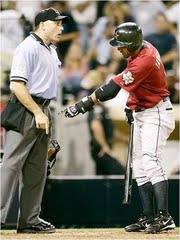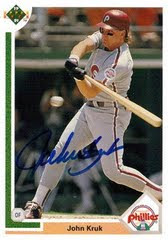The vast majority of fantasy experts, including me, will tell you to draft a RB first and probably 2 RBs in the first two or three rounds. They tell you to do this because it is safer to have RBs and having good elite RBs will help your team. However, there is a new approach arising among the minority, saying that if you don't draft a RB first, and you draft wide receivers instead, you will be fine. So which approach is better? Well, I intend to figure that out.
In 2008, out of the top 25 fantasy performers, 10 were RBs, 12 were QBs, and 3 were WRs. So your first reaction should be, why not draft a good QB considering they seem to be huge fantasy producers? However, as Yahoo! as kindly showed us, getting an elite QB is probably more of a detriment than an advantage. So that leaves only WR and RB (you can obviously wait to get a TE, K, and DEF). The best ranked WR was Larry Fitzgerald and he was the 15th best fantasy producer. Andre Johnson was the #2 wide out and the 23rd best fantasy producer and Calvin Johnson was 25th overall.
And although I believe and maintain that if you have a good corps of RB and a decent set of WRs, you can win your fantasy league. And if you look at fantasy production, it definitely shows that RBs produce more than receivers do. But the problem is where to find the elite RBs. Here's a list of the top ten fantasy RBs and which round they got drafted last year*
1) DeAngelo Williams (7)
2) Michael Turner (3)
3) Adrian Peterson (1)
4) Thomas Jones (4)
5) Matt Forte (5)
6) LaDainian Tomlinson (1)
7) Steve Slaton (undrafted)
8) Brian Westbrook (1)
9) Clinton Portis (1)
10) Maurice Jones-Drew (2)
AD and LT went 1 and 2 in essentially all drafts so getting or not getting one of those two guys had nothing to do with your draft strategy. But if you didn't have a high draft pick, you could have drafted two wide receivers, let's say Andre Johnson and Larry Fitzgerald (both went in the second round) and still gotten guys like Forte, Jones, Turner or picked up Slaton in waivers. That way you would have two elite WR AND RBs, even though you drafted WRs first.
But the equation gets even more complicated when you look at the production of how the RBs in the first two round produced. Barring injury (which you can't really take into account when drafting), the top RBs still produced. Here's a list of the top ten RBs drafted* and their overall fantasy production among wide outs and running backs. (I'm excluding LT and AP because this is a post about draft strategy and the first two guys off the board has nothing to do with strategy)
3) Steven Jackson (17)
4) Brian Westbrook (9)
5) Joseph Addai (67)
6) Marion Barber (23)
7) Frank Gore (18)
8) Marshawn Lynch (19)
9) Clinton Portis (10)
10) Larry Johnson (53)
11) MJD (11)
12) Laurence Maroney (only played in 3 weeks)
Addai, Johnson, and Maroney all got injured so it makes sense that their numbers are so low. But now let's take a look at how well the top ten drafted receivers* and their overall fantasy value compared to all WRs and RBs:
1) Randy Moss (30)
2) T.O. (29)
3) Reggie Wayne (35)
4) Andre Johnson (12)
5) Braylon Edwards (72)
6) Steve Smith (20)
7) Larry Fitzgerald (7)
8) T.J. Houshmandzadeh (66)
9) Marques Colston (73)
10) Torry Holt (83)
Out of this group only Colston was injured. The low numbers of Holt, Edwards, and Housh were due to their suckiness and nothing more.
The average production position of a top ten RB (excluding LT and AD and including more injured players) was ranked 25.2. The average production position of the top ten receivers was ranked 42.7. That's not even close. Granted RB seem more injury prone than WR, but still put up much more numbers.
Now I understand this study is just based on one year, and just based on one draft, but I would put money that results like this show up year after year. I would put money on this just because of the nature of the position. First RB are far more likely to score TDs. If you have an average RB and an average receivers, I'm sure they would put up similar numbers. But you're looking for the elite wide out and the elite back to build you team upon. You want to build your team around your WR and RB corps so you want the best of the best. And the elite RB will get a lot more TD opportunities and TDs than the elite receiver. The back is also more likely to touch the ball. The back is guaranteed to touch the ball. Even a really good back up like what MJD has been is guaranteed to get touches. A receiver is never guaranteed to even get thrown to nevertheless catch passes. Now a receiver can do a shit ton of damage with only three receptions, but it's still an unknown every game. RBs are more of a sure thing.
So final conclusion: which approach is better, drafting RBs first and then WR or vice versa? Well, it depends on how good of a drafter/ trader you are. I don't think either approach is out of the question. I don't think it's so rogue as many experts might think it is, but it's harder and riskier. There were many RBs like Reggie Bush, LenDale White, Fred Taylor, Rudi Johnson, and Julius Jones that went in the 4th, 5th, or 6th rounds that didn't nearly produce like Matt Forte or DeAngelo Williams did. There were also many WR like T.O. and T.J. Who's-Your-Mama that went early, and seemed like sure things, that also did not produce like others like Fitz, and A Johnson did.
That is why I, like many many others, tell you to draft RBs early. Your first rounder may not have produced like you had hoped he would, but he still was a damn choice you made. It's just safer to draft RBs over WRs.
So just remember, do your homework! That's all it is. There is plenty of value in the later rounds that can help your team, it's just knowing where to look for them plus a lot of luck. It is obviously possible to dominate drafting WRs first then go look for your backs, but it's much harder to do. And I think that's why many people stray away from it and suggest the RB norm.
So good luck and happy drafting!
*based on my 2008 Yahoo! draft last year
The 2 RB vs the 2 WR Approach
Posted by
Adam Kaplan
on Friday, August 7, 2009
Labels:
Sexy Rexy's Fantasy Advice







0 comments:
Post a Comment